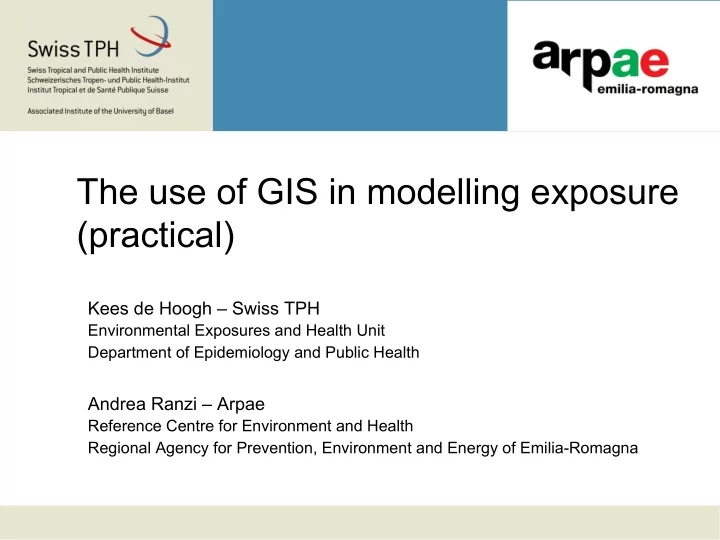

The use of GIS in modelling exposure (practical) Kees de Hoogh – Swiss TPH Environmental Exposures and Health Unit Department of Epidemiology and Public Health Andrea Ranzi – Arpae Reference Centre for Environment and Health Regional Agency for Prevention, Environment and Energy of Emilia-Romagna
Learning outcomes We will present practical examples on use of GIS for exposure assessment in epi studies and HIA School on IEHIA on air pollution and climate change in Mediterranean urban settings 25/04/18 2
Example 1: Use of dispersion model to assess population exposure Air Pollution from Incinerators and Reproductive Outcomes Candela et al. Epidemiology 2013 25/04/18 School on IEHIA on air pollution and climate change in Mediterranean urban 3 settings
Moniter Project Monitoring incinerators in the territory of Emilia-Romagna
Study Population Modena
Final Database Subjec t ID (x,y) Database of Database of Database of gecoded population data residential history addresses (i.e. a record for each subject residence)
Exposure assessment Incinerator (PM10) All sources (NOx)
Environmental study Traffic Civil sources Industry Incinerator Emission map Dispersion model METEO DATA distribution of concentration at ground level
ADMS urban software
ADMS OUTPUT
ADMS OUTPUT
Residential cohort and ADMS output
KRIGING
Residential cohort
CENSUS DATA
Application of Overlay analysis Point-in-polygon Line-in-polygon Polygon-on-polygon Input layer Overlay layer Output layer inherits overlay layer’s attributes 25/04/18 School on IEHIA on air pollution and climate change in Mediterranean urban 16 settings
Example 2: Use of large routine data Example on Waste-related exposure: how calculate EBD related to exposure to landfills in Europe Today Number of exposed people using European databases GIS approach to exposure assessment • Tomorrow (IEHIA lecture) Use RR from literature and Calculation of AC (Attributable Cases) Combination of different health outcomes in one analysis using DALYs
Data collection Location of plants Population database European health statistics
Location of plants – E-PRTR register http://www.eea.europa.eu/data-and-maps/data/member-states-reporting-art-7- under-the-european-pollutant-release-and-transfer-register-e-prtr-regulation-10
E-PRTR E-PRTR data covering reporting for 2007 to 2014 by EU Member States, l Iceland, Liechtenstein, Norway, Serbia and Switzerland. Article 7 of the Regulation sets the requirements for the annual reporting by l Member States which covers the releases to air and water for 91 substances, as well as the transfers of pollutants in water and the transfer of waste from industrial facilities across 65 sectors. The register includes information of more than 30.000 facilities in 32 countries.
E-PRTR (Sector 5.d – 2014 data) Sector: 5.(d): Landfills (excluding landfills of inert waste and landfills, which were definitely closed before 16.7.2001 or for which the after-care phase required by the competent authorities according to Article 13 of Council Directive 1999/31/EC of 26 April 1999 on the landfill of waste (3) has expired). Capacity threshold: Receiving 10 tonnes per day or with a total capacity of 25 000 tonnes Geocode: *.mkz file from EEA website (plants updated to 2014)
Population Data are available at 100 meters resolution. Population by municipality correspond to Census 2001 (Eurostat). Owners and Processors: Joint Research Centre (JRC) http://www.eea.europa.eu/data-and-maps/data/population-density- disaggregated-with-corine-land-cover-2000-2 Reference: Gallego F.J., 2010, A population density grid of the European Union, Population and Environment. 31: 460-473 http://www.springerlink.com/content/h22617v812p51014/? p=a5de0fad279b474187e630362f4f2fc8&pi=3
Population
E-PRTR data – Kmz file
KMZ to layer 25/04/18 School on IEHIA on air pollution and climate change in Mediterranean urban 26 settings
*.MKZ
Buffering
Population data
How to calculate exposed people ArcGIS function: “Clip” raster to select squares, then calculation of sum of values GME free package (http://www.spatialecology.com/gme/, ArcGIS and R are required in your PC) 1. Function: isectpolyrst(in= polygon shapefile with buffers , raster= rasterfile with population , prefix="Pop", metrics=c("CNT","SUM","MEAN","STD"), allowpartialoverlap=TRUE); At the end, each population number has to be divided by 100 (as it represents 1x1 km density on 100x100 m, see Gallego et al.)
GME free package
Italy DATA The geographic coordinate of waste management site The population distribution in the census block by gender and by age
Modena Incinerator: Selection criteria Step 1 Use the proximity analysis tool to create buffer to a specific distance around the site of study. in the present example case: 1km 2km 3km
ARCMAP – BUFFER window 25/04/18 School on IEHIA on air pollution and climate change in Mediterranean urban 34 settings
Modena Incinerator: Selection criteria 3 KM buffer Some census block are completely within the buffer Some others intersect the buffer Step 2 Chose the selection criteria
Modena Incinerator: Selection criteria completely within the buffer intersect the buffer Question .. How can we estimate people living in the “red” census block?
Estimating population exposure we assume an homogeneous distribution of population in a census block Step 3 Intersect buffer and census block to extract the real area at 3km from incinerator Step 4 Calculate the area within the buffer Step 5 Calculate the population proportionally of square meters Pop ⎛ ⎞ ( ) area _ i ∑ ⎜ ⎟ ∗ ⎜ ⎟ TOTarea _ CensusBloc k ⎝ ⎠
ARCMAP – INTERSECT window 25/04/18 School on IEHIA on air pollution and climate change in Mediterranean urban 38 settings
tomorrow with health data and HIA calculations …
LUR models - predictor variables 25/04/18 School on IEHIA on air pollution and climate change in Mediterranean urban 40 settings
Example 3: PM2.5 at urban level Example on exp ass on pm2.5 or pm10 for burden of disease - VIIAS italian project (info at regional level) - Regional air quality plan (info at municipality level) - Calculate mean of values of PM and total population that fall into a region (i.e. census block) Italy (2005) Bologna, with census block and pm2.5 dispersion model 25/04/18 School on IEHIA on air pollution and climate change in Mediterranean urban 42 settings
Methods: estimating population exposure Census block Grid 4x4km Pop areaInt × ∑ areaCensus Block Intersect grid and census block to extract the area in each cell 4x4km Calculate the area within each cell Calculate the population proportionally of square meters
25/04/18 School on IEHIA on air pollution and climate change in Mediterranean urban 44 settings
Recommend
More recommend